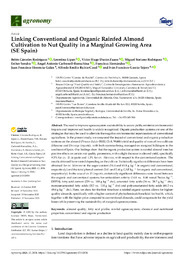Título :
Linking Conventional and Organic Rainfed Almond Cultivation to Nut Quality in a Marginal Growing Area (SE Spain) |
Autor :
Hernández, Francisca
Cárceles Rodríguez, Belén
Lipan, Leontina
DURAN ZUAZO, VICTOR HUGO 
Soriano Rodríguez, Miguel 
Sendra, Esther
Carbonell-Barrachina, Ángel A.
Herencia Galán, Juan Francisco
Rubio-Casal, Alfredo Emilio 
García-Tejero, Iván Francisco |
Editor :
MDPI |
Departamento:
Departamentos de la UMH::Producción Vegetal y Microbiología |
Fecha de publicación:
2023-11 |
URI :
https://hdl.handle.net/11000/32384 |
Resumen :
The need to improve agroecosystem sustainability to secure yields, minimize environmental
impacts and improve soil health is widely recognized. Organic production systems are one of the
strategies that may be used to alleviate the negative environmental repercussions of conventional
agriculture. In the present study, we compared the impact of conventional and organic production
systems on the almond (Prunus dulcis (Mill.) D.A. Webb) yield and quality of nuts of two cultivars
(Marcona and Desmayo largueta), with both systems being managed on marginal hillslopes in the
southeast of Spain. Our findings show that the organic production system in rainfed almond trees has
positive effects on certain nut quality parameters, with a slight decrease in almond yield, specifically
9.5% for cv. D. largueta and 1.3% for cv. Marcona, with respect to the conventional system. The
results obtained have varied depending on the cultivar. Statistically significant differences have been
obtained for cv. Marcona in the sugar content (54.4 and 49.8 g kg−1
in organic and conventional,
respectively) and the total phenol content (3.41 and 2.46 g GAE kg−1
for organic and conventional,
respectively). In the case of cv D. largueta, statistically significant differences were found between
the organic and conventional systems for antioxidant activity (14.8 vs. 8.68 mmol Trolox kg−1
,
DPPH), fatty acid content (229 vs. 188 g kg−1 dw), saturated fatty acids (36 vs. 28.7 g kg−1 dw),
monounsaturated fatty acids (113 vs. 110 g kg−1 dw) and polyunsaturated fatty acids (60.3 vs.
49.6 g kg−1 dw). Here, we show for the first time how a rainfed organic system allows for higherquality almonds, specifically with a higher content of phytochemicals beneficial for health, which,
together with the higher price compared to conventional almonds, could compensate for the yield
losses while preserving the sustainability of marginal agroecosystems.
|
Palabras clave/Materias:
almond quality
fatty acid profile
rainfed agroecosystem
chemical and nutritional properties
conventional and organic production |
Área de conocimiento :
CDU: Ciencias aplicadas: Agricultura. Silvicultura. Zootecnia. Caza. Pesca |
Tipo de documento :
info:eu-repo/semantics/article |
Derechos de acceso:
info:eu-repo/semantics/openAccess |
DOI :
https://doi.org/10.3390/agronomy13112834 |
Publicado en:
Agronomy 2023, 13. |
Aparece en las colecciones:
Artículos - Producción vegetal y microbiología
|
 La licencia se describe como: Atribución-NonComercial-NoDerivada 4.0 Internacional.
La licencia se describe como: Atribución-NonComercial-NoDerivada 4.0 Internacional.
.png)
